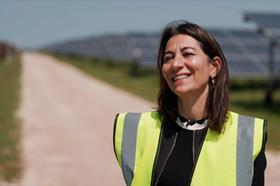Infra
Vodafone UK aims to contain opex with ‘green’ infrastructure investment

Vodafone UK has an ambition to keep energy consumption and operating costs flat even as it invests in new sites to create a distributed, edge-based network architecture as part of its multi-year Redstream Evolution programme.

Francesca Serravalle, Head of Infrastructure and Energy at Vodafone UK, said energy efficiency is one of the key criteria for the design of what she called a “green, interconnected, edge-based infrastructure”, speaking at TelecomTV’s DSP Leaders World Forum event this week.
The energy savings are derived from some investments in on-site power generation solutions, but mostly from simplifying infrastructure and retiring legacy equipment. Indeed, the Redstream project has combined three separate networks for mobile, broadband, and enterprise customers onto one converged backbone network. The OpCo also switched off its 3G network in February 2024.
“ We can only deliver a green network if we have a green infrastructure. We are deploying solar panels in our core and data centres, simplifying the network, closing sites, and switching off platforms. ”
Serravalle.
As it modernises infrastructure, Vodafone wants to break the linear relationship between network and data growth and energy consumption.
“ We gave ourselves a challenge that no matter if we’re rollout out 5G and if data is growing, we want to keep the energy consumption flat. And it was quite a big challenge. ”
Serravalle.
That has involved simplifying the network and accelerating the transition from legacy to “cloudified” networks so that the operator does not have a “double stack” of legacy and new networks and IT systems, she explained.
The OpCo is working on big data uses cases, such as analysing energy data from passive and active infrastructure to create a “heat map for where we could take target action”. It is also exploring adding more intelligence to radios, to dynamically change power output based on usage patterns.
Vodafone has existing deployments of usage monitoring tech in a handful of markets. Dutch joint venture VodafoneZiggo claims to have “dozens” of measures in place to measure and reduce energy consumption, and in 2023 became the first OpCo to deploy ‘smart’ network technology that changes power consumption to match network demand. Vodafone Ireland followed suit, and Vodafone Germany partnered Ericsson for energy-saving “active” radio tech later in the year (Vodafonewatch, #213, #216, and #222).
Spending small on on-site power tech
Vodafone Group invested €31m (£26m) in energy efficiency capital expenditure and “on-site renewable projects”, resulting in an annual savings of 11 gigawatt hours (GWh), in the year to 31 March 2024 (FY23–24).
The investment is a small fraction of the Group’s total €6.3bn capex for the year. It is also down 45% from €57m spent on energy efficiency capex in the previous year. The dwindling capex for on-site energy, although in line with the Group’s cutbacks on overall spending, suggests the operator is looking to more efficient next-generation networks and removing power-hungry legacy kit to deliver the bulk of network opex savings, rather than from on-site power generation solutions.

For example, speaking at the same DSP Leaders event, Yago Tenorio, Fellow and Director of Network Architecture at Vodafone, highlighted the energy savings potential of open RAN technology. The operator aims to migrate 30% of its European footprint to open RAN by 2030.
The Group has launched a RAN tender for 170,000 sites across Europe and Africa and one of the key aims is for better energy efficiency. Radio units are a “significant” portion of RAN capex but they take a “disproportionate majority of opex” due to energy consumption, he explained.
Through this tender, the operator is in the process of procuring 32 different radios to suite various frequencies and deployment scenarios. Tenorio claimed that if the solutions could be built in an ideal open RAN “mix and match” way, taking the best products to create a stack with the lowest energy consumption, then the opex savings would be €1bn for its European footprint, “in theory”.
“ Open RAN versus the old world is €1bn better in energy consumption throughout the life of equipment [10 years]. ”
Tenorio.
Vodafone has installed solar panels at sites in Albania, Egypt, Germany, Turkey, and the UK, boosting the Group’s on-site renewable electricity generation to 21 GWh per year. The Group is also trialling other solutions. In Egypt, the operator has tested sites that are powered only by solar and wind. In the Democratic Republic of Congo, the operator plans to implement more “micro-grids”, according to the Group’s Annual Report 2024.
More edge investment to come with Redstream overhaul
In the UK, the multi-year Redstream Evolution programme is at the heart of Vodafone’s network upgrade and entered the final stages in July 2023. The converged backbone network is software defined network (SDN)-enabled and provides core IP transport for the operator’s mobile, broadband, and enterprise customers.
The network is made up of more than 200 core sites, connected by in excess of 11,000km of fibre, with more than 1,000 multi-protocol label switching-enabled aggregation nodes.
Serravalle said that the key criteria for the architecture design were “future proofing”, “scalability”, and “keeping the opex flat”. As for increased capacity, the network is built with “10GB access, 100GB aggregation, and 800GB core”.
The project has created an “edge-based architecture” that enables “low-latency services” as well as “local breakout”, said Serravalle. The OpCo has previously flagged the operational efficiency advantages of operating one instead of three networks as well as from “better, automated network and capacity management”.
As part of the Redstream programme, Serravalle said the OpCo has also chosen some sites for its “on-premise” telco cloud, “our virtualised core”. The operator’s Network Function Virtualisation infrastructure (NFVi) is based on VMware, while hardware comes from Dell and HPE.
“ We have looked at the demand and we have created an investment roadmap that delivers megawatts… not kilowatts… It’s a big investment if you have an on-prem cloud approach and you have to deliver megawatts. It’s not cheap… it’s a big project. ”
Serravalle.







:max_bytes(150000):strip_icc()/roundup-writereditor-loved-deals-tout-f5de51f85de145b2b1eb99cdb7b6cb84.jpg)


